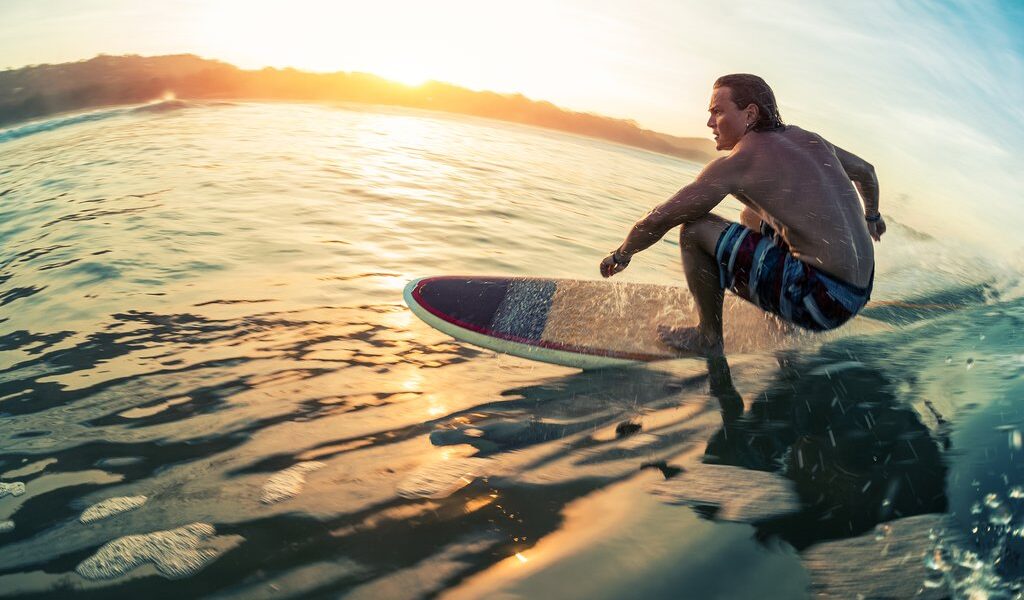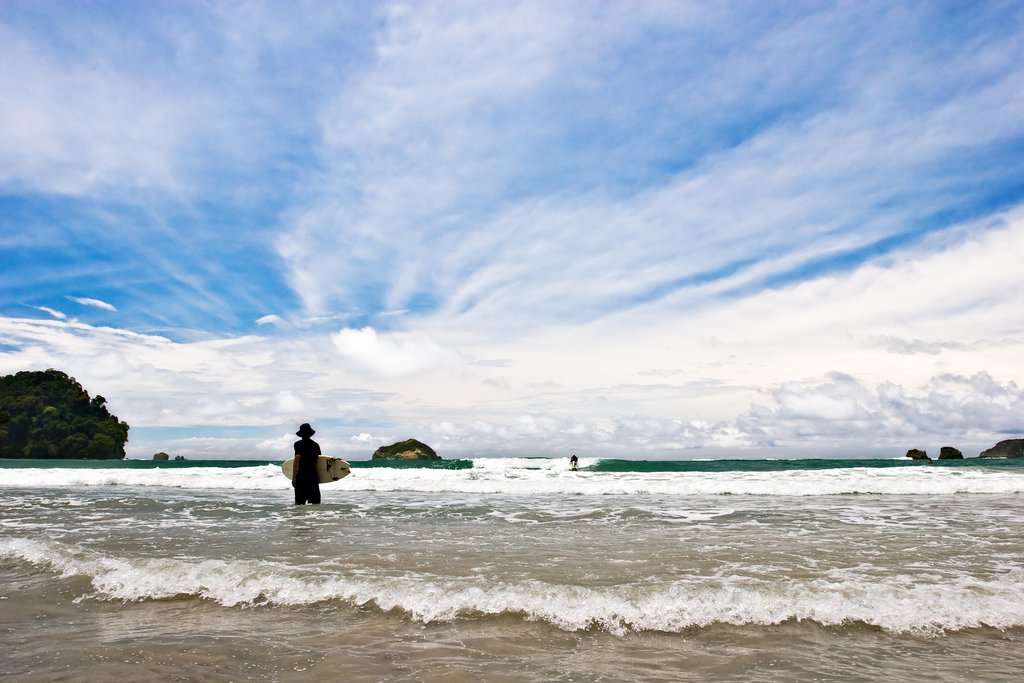
Costa Rica certainly lives up to its name (literally ‘Rich Coast’), blessed as it is with miles of beaches on both its Pacific and Caribbean coasts. The country has long recognized the value of preserving its stunning environmental assets, making this relatively diminutive nation a leader in conservation. As one of the happy consequences, Costa Rica’s rivers, lakes, and seas provide abundant opportunity for endless outdoor adventures.
## Surfing in Costa Rica: Riding the Waves of Paradise
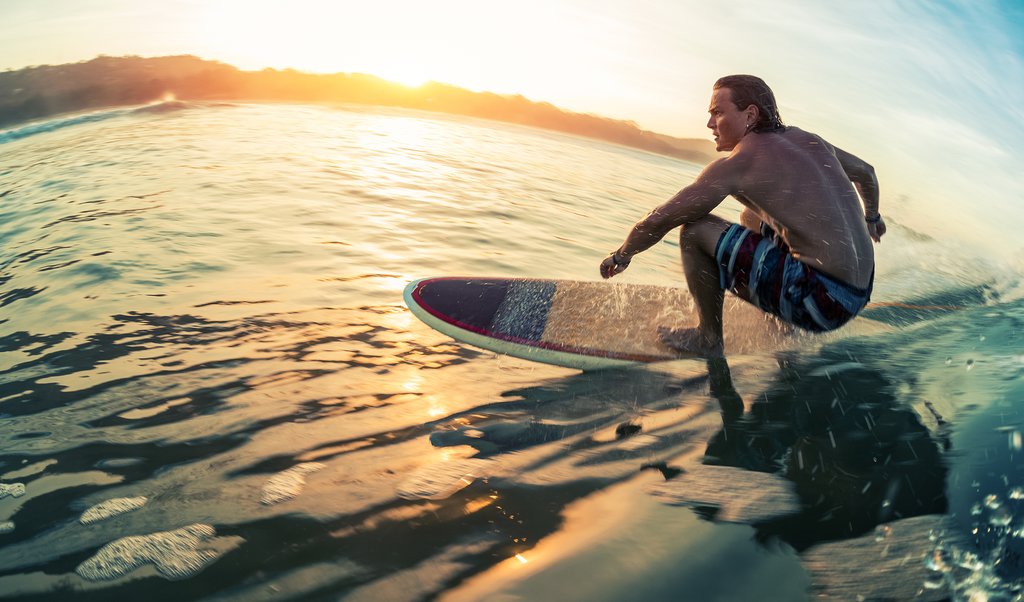
Costa Rica, a jewel of Central America, beckons surfers from every corner of the globe throughout the year, and for incredibly valid reasons. The geographic positioning of this vibrant nation blesses it with a unique advantage: when the oceanic swell isn’t quite right along one coastline, the waves are almost guaranteed to be pumping on the other. This constant opportunity to catch a great wave makes Costa Rica a true surfer’s paradise. While the Caribbean coast is often better suited for surfers with significant experience under their belts, the Pacific coast boasts a plethora of breaks that cater to surfers of all skill levels, from absolute beginners to seasoned veterans. The consistent waves and warm waters make it an ideal destination to either learn the sport or hone existing skills.
For those who are just beginning their surfing journey, Costa Rica provides an embarrassment of riches, with a vast selection of picturesque locales perfectly tailored for novice surfers. Surf schools and surf camps are abundant, stretching up and down the breathtaking Pacific coast. These institutions offer comprehensive instruction, ensuring that beginners can learn the fundamentals of surfing in a safe and supportive environment. On the stunning Nicoya Peninsula, nestled within the Guanacaste region of northern Costa Rica, you’ll find Tamarindo, a town with a long and storied history as an expat haven. The rivermouth break here is particularly well-suited for beginners, providing gentle and forgiving waves to learn on. Furthermore, the well-developed town of Tamarindo offers a diverse array of dining options, lively bars, and other forms of entertainment for that well-deserved après-surf relaxation. More experienced surfers seeking a more challenging ride will discover bigger and more powerful waves both to the north and south of Tamarindo, in renowned surf spots such as Playa Grande, Playa Avellanas, and many other hidden gems waiting to be explored.
If you’re craving a more laid-back and bohemian experience, consider venturing farther south on the Nicoya Peninsula. Here, you’ll encounter the charming towns of Nosara and Sámara, both of which offer excellent surfing opportunities and a more relaxed pace of life. Alternatively, you could complement your exhilarating surf sessions with rejuvenating yoga practices and nourishing clean cuisine towards the southern tip of the peninsula in the tranquil haven of Malpaís. This combination of surfing, wellness, and healthy living provides a truly holistic and unforgettable experience.
Moving towards the central Pacific coast, you’ll find the popular town of Jacó. This bustling hub offers a mix of surf schools for beginners and more challenging breaks for experienced surfers, ensuring that everyone can find their perfect wave. Jacó also boasts a wide range of accommodation options, delectable dining experiences, and a vibrant nightlife scene. Further south along the coast lies the more rustic Playa Dominical, which perfectly embodies the quintessential Costa Rican surf town. With its authentic fishing-village atmosphere, lively local bars, and affordable yet healthy food options, Playa Dominical offers a true taste of the local culture.
Finally, for the truly adventurous and experienced surfers, the Caribbean coast presents the formidable Salsa Brava, a legendary reef break known for its powerful and challenging waves. Surfing Salsa Brava is not for the faint of heart, but it offers an unparalleled adrenaline rush for those who dare to take it on. Furthermore, the Caribbean coast provides a welcome change of cultural pace, with its unique Caribbean soul and a relaxed, reggae-infused vibe. This distinct cultural flavour adds another layer of richness to the Costa Rican surfing experience.
## Whitewater Rafting & Kayaking: Conquer Costa Rica’s Rivers
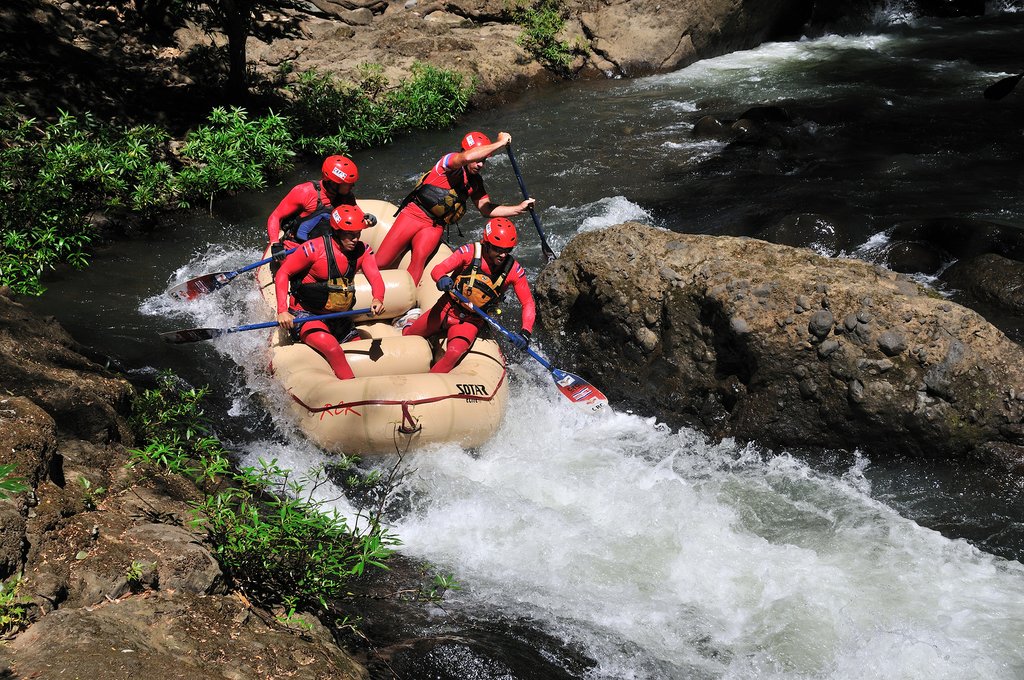
If the thrill of navigating roaring rapids is more your style, Costa Rica’s diverse and abundant river systems will undoubtedly deliver an unforgettable adventure. Kayakers, too, will find their aquatic paradise here, whether they seek the adrenaline-pumping excitement of whitewater rapids, the peaceful serenity of the ocean, or the tranquil beauty of mangrove forests. Costa Rica provides a diverse range of kayaking experiences to suit every preference and skill level.
For those seeking the ultimate adrenaline rush, your best bet lies within the breathtaking tropical gorge of the Río Pacuare, located in the heart of central Costa Rica. The Río Pacuare is widely regarded as one of the most scenic and thrilling whitewater rafting destinations in the world. On the Pacuare, the rapids are rated up to Class V, signifying their intensity and challenge. However, most rafting trips typically navigate the lower section of the river, which consists of a series of exciting Class III and IV rapids. These rapids provide a perfect balance of adrenaline and exhilaration, suitable for both experienced rafters and adventurous beginners. Multi-day trips can also be arranged on the Pacuare, allowing you to fully immerse yourself in the stunning rainforest setting. These extended trips provide ample opportunities for bird-watching, wildlife sightings, and a deeper appreciation for the natural beauty of Costa Rica.
Alternatively, the Río Sarapiquí, nestled within Costa Rica’s steamy northern lowlands, also offers a plethora of whitewater action. Most tour operators in this region run trips through Class II to Class III rapids, providing a more moderate but equally enjoyable rafting experience. This area of the country is often less crowded than other tourist destinations, offering a more remote and secluded feel. Floating along the Sarapiquí between rapids provides ample opportunities for bird-watching and a relaxed appreciation of the river’s lush and vibrant surroundings. The Río Sarapiquí offers a truly immersive experience in the heart of the Costa Rican rainforest.
Kayaking opportunities are also widely accessible throughout Costa Rica, in a diverse range of environments. Consider embarking on a sea kayaking tour from Playa Carrillo, located on the idyllic Nosara Peninsula, to the tiny Isla Chora. Here, you can embrace the fantasy of being stranded on a deserted tropical island for a day. Alternatively, you can silently paddle through the intricate canals of the wildlife-rich Tortuguero National Park, situated on the Caribbean coast. A knowledgeable guide can point out herons perched gracefully in overhanging branches, caimans lurking just beneath the water’s surface, and monkeys playfully scrambling among the trees. For another kayaking adventure, visit Marino Ballena National Park, where you might be fortunate enough to spot majestic humpback whales or graceful sea turtles in the ocean. You can then gain an intimate perspective of the intricate mangrove forests within the inlets that feed into the Pacific.
## Kiteboarding: Harness the Power of the Wind
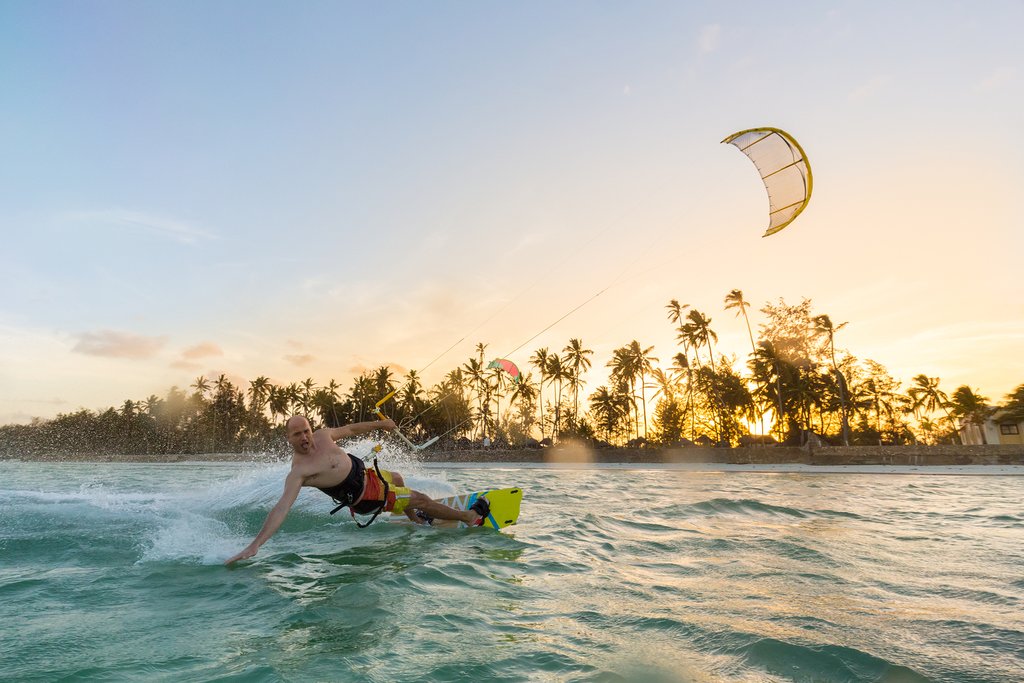
For kiteboarding enthusiasts, Costa Rica is a must-visit destination, particularly during the months of November to May, when consistent and powerful winds sweep across the country. These favourable wind conditions create ideal opportunities for kiteboarders to harness the power of the wind and experience the exhilarating thrill of gliding across the water.
World-class wind conditions draw kiteboarders from around the globe to Laguna de Arenal, a stunning lake where the dormant Volcán Arenal majestically looms above, surrounded by lush mountain greenery. Kiters can launch from the northern end of the lake, which, at an expansive 33 square miles, provides ample space for enthusiasts to play and practice their skills. The vastness of the lake ensures that kiteboarders have plenty of room to maneuver and enjoy the wind.
Kiteboarders also find fantastic wind conditions on the northern Pacific coast at Bahía Salinas, located near the Nicaraguan border. This uncrowded bay, which is not particularly popular with average beachgoers, offers a beautiful setting and perfectly suited conditions for kiting. The unspoiled nature of Bahía Salinas and its consistent winds make it a true kiteboarding paradise.
At both of these kiteboarding meccas, resorts catering specifically to wind worshippers offer licensed instructors for those who are new to the sport. These instructors provide comprehensive lessons, ensuring that beginners can learn the fundamentals of kiteboarding in a safe and supportive environment.
## Diving and Snorkeling: Discover Costa Rica’s Underwater World
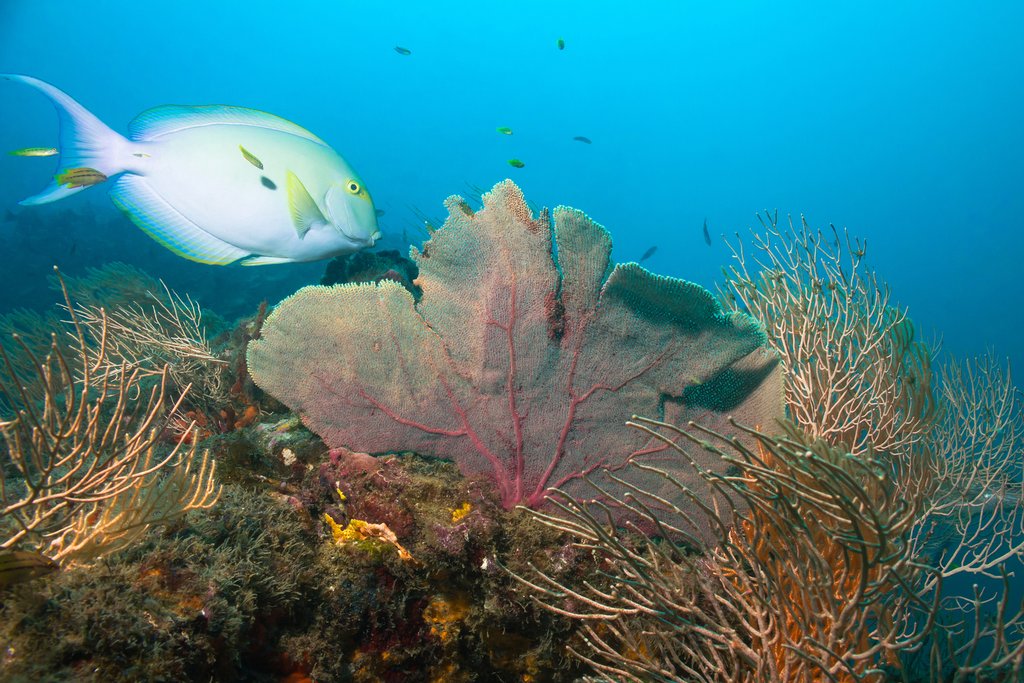
Costa Rica’s most spectacular dive site is, without a doubt, Isla del Coco, located 342 miles offshore from the southwest coast. Avid divers can book multi-day trips on a liveaboard vessel for the incredible privilege of diving in this stunning and remote location. The unique marine ecosystem of Isla del Coco, a UNESCO World Heritage Site, is renowned for its abundance of sharks, rays, and other pelagic species. However, for those who prefer to stay closer to the mainland, a wealth of other diving and snorkeling locales awaits.
Among the most notable is another island, located just 10 miles offshore from the Osa Peninsula. The national park of Isla del Caño features a rugged shoreline that plunges into the deep waters of the Pacific Ocean. Around the island, divers and snorkelers can encounter sea turtles, large schools of pelagic fish, multiple species of sharks, and graceful manta rays. Both day trips and multi-day excursions are available to Isla del Caño.
Another noteworthy dive spot is at the Catalina Islands, a group of approximately 20 small islands situated off the northern Pacific coast. Due to the strong currents in this area, divers must possess an intermediate or advanced skill level to fully appreciate the diverse marine life, including schooling tropical fish, several species of rays, and sharks.
Snorkeling is readily accessible along both the Caribbean and Pacific coasts at numerous locations, where colorful fish, anemones, and sea turtles frequently make appearances. On the Caribbean coast, immerse yourself in the underwater wonders of Gandoca Manzanillo Wildlife Refuge and Cahuita National Park. On the Pacific side, explore the vibrant marine environment of Marino Ballena National Park near Uvita.
## Stand-Up Paddleboarding: Glide Across Costa Rica’s Waters
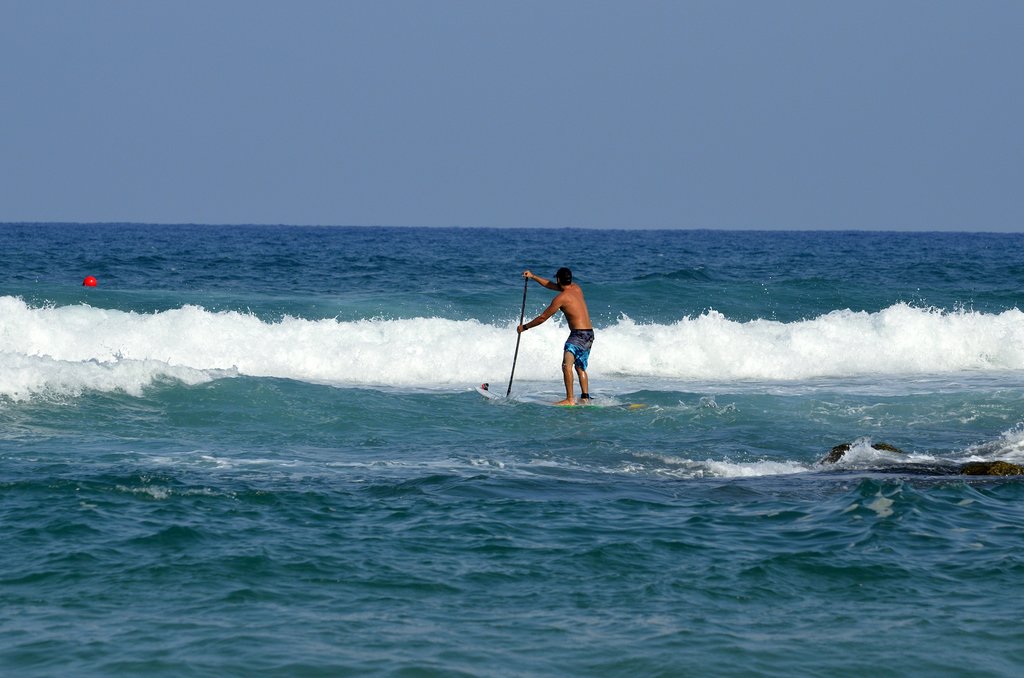
Finally, stand-up paddleboarding (SUP) continues to surge in popularity across Costa Rica. SUP is widely accessible and incredibly fun on both flatwater and in the surf, making it a fantastic activity for people of all ages and skill levels. You’ll find rentals and lessons available from Lake Arenal to both the Pacific and Caribbean coasts, although the sport is particularly well-established along the Pacific coast of the Nicoya Peninsula, with numerous businesses offering lessons and rentals from Tamarindo to Santa Teresa. Before venturing into the water, instructors will typically provide a thorough introduction to proper technique and safety guidelines on the beach, ensuring that participants have a solid foundation for a safe and enjoyable experience.
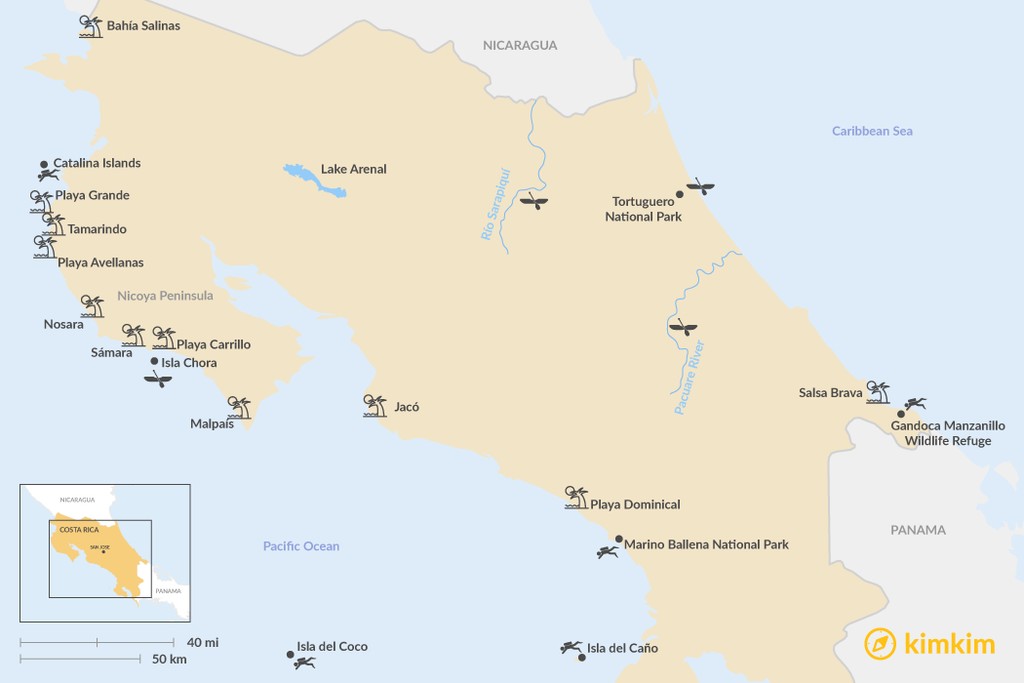
B-563

